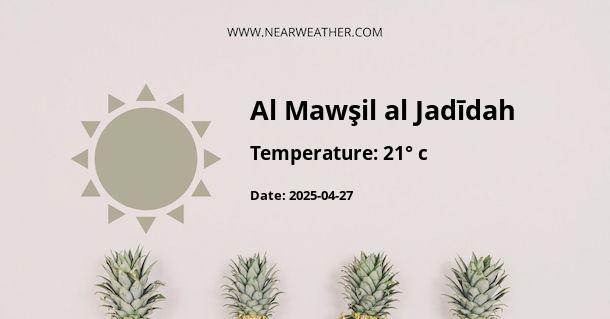Introduction
Al Mawsil al Jadidah, better known as Mosul, is the second-largest city in Iraq. Located in the country's northern region, Mosul's climate and weather patterns significantly influence the city's lifestyle, culture, and economy. This article provides a detailed analysis of Mosul's climate, weather patterns, and the impact these factors have on the city.
Overview of Mosul's Climate
Mosul's climate is classified as a hot desert climate, under the Köppen-Geiger climate classification. This means that the city experiences high temperatures year-round, with very little rainfall. The average annual temperature in Mosul is around 20.1 °C, while the annual precipitation averages 296 mm.
"The hot desert climate of Mosul is characterized by scorching summers, mild winters, and minimal rainfall, making it a challenging environment for agriculture and water management."
Seasonal Weather Patterns in Mosul
1. Summer (June - August)
Summers in Mosul are typically very hot, with temperatures often exceeding 40°C. July is usually the hottest month, with an average high of 43°C. Rainfall is minimal during the summer, with June being the driest month.
2. Autumn (September - November)
The autumn season in Mosul experiences a gradual decrease in temperature. However, the weather remains relatively warm, with average temperatures ranging from 33°C in September to 19°C in November. Rainfall starts to increase slightly during this season.
3. Winter (December - February)
Winters in Mosul are mild compared to other regions. The average temperature ranges between 8°C and 16°C. December and January are the coldest months, with nighttime temperatures occasionally dropping below 0°C. Rainfall is highest in January, making it the wettest month of the year.
4. Spring (March - May)
Spring in Mosul sees a gradual increase in temperatures, with average daily highs ranging from 20°C in March to 33°C in May. Rainfall decreases during this period, making way for the dry summer season.
Impact of Weather on Mosul's Lifestyle and Economy
The hot desert climate significantly affects Mosul's lifestyle and economy. The high temperatures and scarce rainfall limit agricultural activities, making the city heavily reliant on the Tigris River for irrigation. Moreover, the extreme summer heat often leads to increased demand for electricity, straining the city's power infrastructure. On the other hand, the climate also provides opportunities for solar energy production, contributing to the city's energy mix. The weather patterns also influence the city's architecture, with many buildings designed to provide natural cooling.
"Despite the challenges, Mosul's climate also presents opportunities for renewable energy and innovative architectural designs, demonstrating the city's resilience and adaptability."
Conclusion
Understanding Mosul's climate and weather patterns is crucial for both residents and visitors. The city's hot desert climate presents unique challenges and opportunities, shaping the city's lifestyle, culture, and economy. As climate change continues to affect global weather patterns, Mosul's resilience and adaptability will be crucial for the city's future sustainability and growth.
| Season | Average Temperature Range (°C) | Average Rainfall (mm) |
|---|---|---|
| Summer (June - August) | 30 - 43 | 0 - 2 |
| Autumn (September - November) | 19 - 33 | 6 - 24 |
| Winter (December - February) | 8 - 16 | 37 - 69 |
| Spring (March - May) | 20 - 33 | 27 - 39 |
A - Al Mawşil al Jadīdah's Latitude is 36.334641 & Longitude is 43.097771.
A - Weather in Al Mawşil al Jadīdah is 11° today.
A - Climate Conditions in Al Mawşil al Jadīdah shows overcast clouds today.
A - Humidity in Al Mawşil al Jadīdah is 77% today.
A - Wind speed in Al Mawşil al Jadīdah is 1.62 km/h, flowing at 217° wind direction. today.
